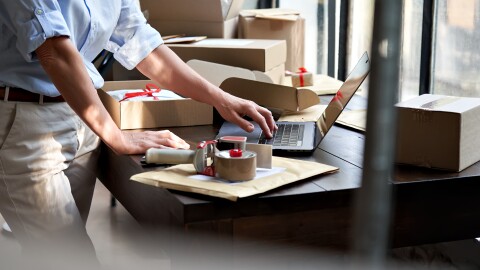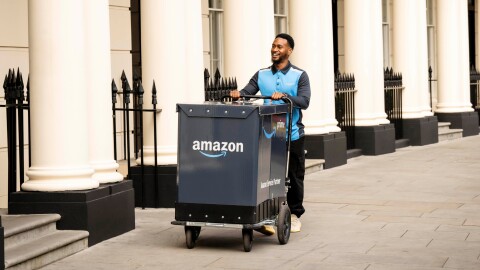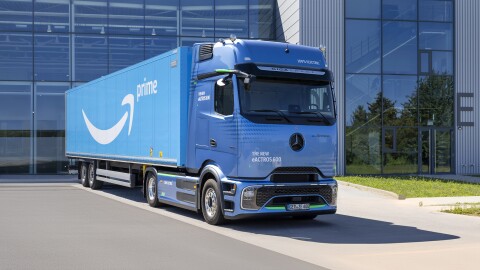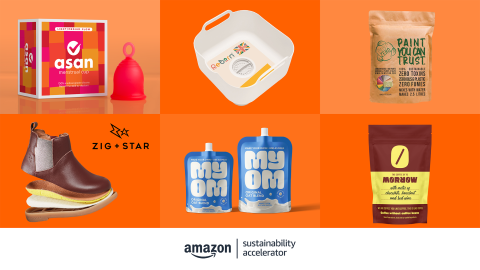Every day at Amazon, we ask ourselves, “How can we make this product, this service, or this experience better for our customers?” We continually seek ways to challenge ourselves and improve how we deliver for our customers, support our employees, and accelerate the pace of innovation.
This mindset is ingrained in our culture, so every day, we apply the same relentless pursuit to delivering progress on our sustainability commitments.
The journey to become more sustainable is not simple or straightforward for any organisation. For a company of the size and broad scope of Amazon, it’s a big challenge. But at Amazon, we don’t shy away from big challenges. We innovate and create. We don’t have all the answers today, but we believe in the need to act now.
Here are some highlights from our 2021 Sustainability Report, which details our commitment to our customers, our people, and the planet.
Through The Climate Pledge, we brought hundreds of partners together to address the climate crisis and help solve the challenges of decarbonising our economy.
The Climate Pledge is a commitment to reach net-zero carbon emissions by 2040—10 years ahead of the Paris Agreement. In 2021, 253 companies joined Amazon as signatories of The Climate Pledge—an increase of more than 700% in signatories over the previous year. Today, the Pledge has more than 300 signatories from over 50 industries and 31 countries.
We delivered millions of packages through more sustainable transportation solutions.
In 2021, more than 100 million packages were delivered to our customers’ doorsteps across Europe with a fleet of over 3,000 electric delivery vans and other zero-emission vehicles. Additionally, over half a million packages were delivered to our customers’ doorsteps in North America with electric vehicles. And in July, we announced that our custom delivery vehicles from Rivian started hitting the road in more than a dozen cities across the U.S.—what is the start of thousands in more than 100 cities by the end of 2022.
We empowered customers to make better shopping decisions.
Through the Climate Pledge Friendly programme, we help customers in the U.S. and Europe discover and shop for more-sustainable products. Since we launched Climate Pledge Friendly in 2020, the number of products included in the programme has grown from 75,000 to more than 250,000 by the end of 2021. In 2021, more than 370 million Climate Pledge Friendly units were shipped to Amazon customers, and we welcomed 20 new third-party sustainability certifications to the programme.
Amazon made significant progress toward our 100% renewable energy commitment.
In 2021, we reached 85% renewable energy across our business. With 274 renewable projects announced as of the end of 2021, Amazon is the world’s largest corporate purchaser of renewable energy and is on path to powering our operations with 100% renewable energy by 2025—five years ahead of our original target of 2030. Today, Amazon has 310 renewable energy projects across 19 countries.
We invested in visionary companies to facilitate the transition to a low-carbon economy.
Through our $2 billion Climate Pledge Fund, Amazon invested in 13 companies in 2021 to accelerate sustainability progress across the areas of transportation, aviation, freight, packaging, farming, and technology. Today, Amazon has now invested in a total of 18 companies, including Rivian, Redwood Materials, Turntide, CarbonCure, Pachama, Infinium, ZeroAvia, BETA Technologies, ION Energy, CMC, Resilient Power, Hippo Harvest, Amogy, Ambient Photonics, Brimstone, Verne, and most recently, Electric Hydrogen and Sunfire.
Amazon led new partnerships to decarbonise hard-to-abate sectors.
We joined the Sustainable Aviation Buyers Alliance in 2021 and became one of the group’s founding members to drive investment and send market signals in support of sustainable aviation fuel. We helped launch Cargo Owners for Zero Emission Vessels (coZEV) with the Aspen Institute. Through coZEV, Amazon is supporting initiatives to increase the availability of zero-emission technologies and fuels. We also became a founding private sector member of the First Movers Coalition to lead decarbonisation of the maritime shipping industry.
We supported the communities where we serve.
We provided relief for 28 natural disasters, and we donated more than 18 million relief supplies and emergency aid items since 2017. We also look to the future by providing programmes that support science, technology, engineering, and math (STEM) education and skills training. Amazon Future Engineer, our global childhood-to-career computer science programme, reached 1.8 million students in 2021.
In January 2021, Amazon launched the Amazon Housing Equity Fund, a commitment of over $2 billion to preserve and create more than 20,000 affordable homes in three communities where we have a high concentration of employees: Washington state’s Puget Sound region; Washington, D.C., and Arlington, Virginia; and Nashville, Tennessee.
Amazon improved our packaging to deliver more safely and sustainably.
Frustration-Free Packaging (FFP) is Amazon’s flagship programme designed to offer more-sustainable packaging that is easy to open, fully recyclable, and capable of shipping without additional packaging protection. By the end of 2021, more than 2 million products qualified under our FFP programmes.
Through our collective efforts, we avoided over 30,000 tonnes of plastic across North America in 2021. In Europe, we switched from single-use plastic delivery bags to recyclable paper delivery bags and cardboard envelopes for orders shipped from fulfillment centers. In Australia, we replaced all single-use air pillows with 100% recyclable paper material to protect goods during shipping.
Amazon minimized food waste and increased food donations to communities in need.
Amazon is committed to reducing food waste by 50% across our U.S. and Europe operations by 2030. To achieve this, we are optimising our food inventory management systems to minimise waste from the outset and prioritising ways to avoid landfills.
In 2021, we donated 85 million pounds of food—equivalent to more than 70 million meals—in the U.S. through Feeding America, and in Europe, we donated more than 4,000 tonnes of food—equivalent to 10 million meals. For food that can’t be donated, we turn to processes that avoid landfills, such as composting and anaerobic digestion.
AWS focused on energy and water efficiency for our data centers.
AWS is focused on efficiency and continuous innovation across its global infrastructure to build a sustainable business for customers and the planet. AWS Graviton3 processors became our latest generation of AWS-designed Graviton processors in 2021, with Graviton3-based instances using up to 60% less energy for the same performance than non-Graviton Amazon Elastic Compute Cloud (Amazon EC2) instances.
AWS also implemented strategies such as evaporative cooling, on-site water treatment, and recycled water systems for cooling purposes. For example, up to 96% of all spent cooling water from AWS data centers in one community is sent to local farmers to help grow crops like corn, soybean, and wheat.
We decreased our overall carbon intensity during a time of rapid growth.
Even as we scaled our business at an unprecedented pace to help meet the needs of our customers through the pandemic, we saw a 1.9% reduction in our carbon intensity in 2021.
As we invest in new products and services, it will continue to be important for us to measure how fast we reduce our carbon intensity so we can both meet our customer needs and reach our net-zero carbon goal. We thrive on big challenges, and with our relentless culture of innovation and a tenacious team of sustainability scientists and professionals, we are committed to reaching net-zero emissions by 2040.
Our Road Ahead
Operating sustainably is no longer a choice—it’s an imperative. Making meaningful progress to address climate change takes unprecedented action across all industries and societies. We recognise this and acknowledge that the ways we do business have impacts far beyond our own company.
With no time to waste, we are investing in efforts to protect the environments of the people and communities we serve—both now and in the future.
Find out more about Amazon's commitment to sustainability. Read our 2021 Sustainability Report in full.











